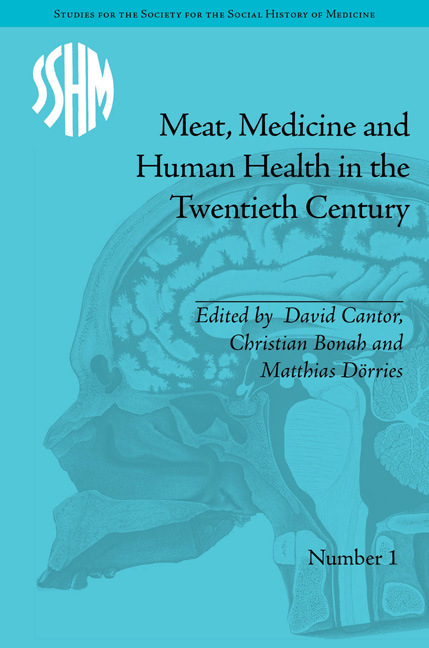Book contents
- Frontmatter
- CONTENTS
- Acknowledgements
- List of Contributors
- List of Figures and Tables
- Introduction
- Part 1 Meat and Therapeutics
- 1 Zomine: A Tale of Raw Meat, Tuberculosis, Industry and War in Early Twentieth Century France
- 2 Treat with Meat: Protein, Palatability and Pernicious Anaemia in the 1920s–30s
- 3 How Abattoir ‘Biotrash’ Connected the Social Worlds of the University Laboratory and the Disassembly Line
- Part II Meat, Politics and Culture
- Part III Meat, Risk and Regulation
- Notes
- Index
3 - How Abattoir ‘Biotrash’ Connected the Social Worlds of the University Laboratory and the Disassembly Line
from Part 1 - Meat and Therapeutics
- Frontmatter
- CONTENTS
- Acknowledgements
- List of Contributors
- List of Figures and Tables
- Introduction
- Part 1 Meat and Therapeutics
- 1 Zomine: A Tale of Raw Meat, Tuberculosis, Industry and War in Early Twentieth Century France
- 2 Treat with Meat: Protein, Palatability and Pernicious Anaemia in the 1920s–30s
- 3 How Abattoir ‘Biotrash’ Connected the Social Worlds of the University Laboratory and the Disassembly Line
- Part II Meat, Politics and Culture
- Part III Meat, Risk and Regulation
- Notes
- Index
Summary
It is generally accepted that both the American meatpacking industry and modern endocrinology originated in the latter half of the nineteenth century. However, generally their development has not been linked. A typical history of the meatpacking industry begins shortly after the Civil War (1861–5) with the meat barons, as its pioneers came to be known, taking advantage of the widening rail network, and transporting livestock from farms and ranches, mostly in the west, to the railway hub in Chicago where feedlots, slaughterhouses and factories had been set up. The introduction of chill rooms allowed livestock to be slaughtered during the summer heat and extended the shelf life of fresh table meat which was dispatched by rail in refrigerator cars to the gathering crowds of urban consumers, mostly in the east, whose appetite for it was apparently insatiable. The disassembly line, introduced in the late 1880s, was the innovation that came to define modern meatpacking. In traditional slaughterhouses one or two men performed all the tasks involved in killing, dressing and cutting up an animal. The disassembly line combined engineering and scientific management: a continuous conveyer took the carcass of a freshly slaughtered animal hanging from a chain around its legs past a series of workstations where a man stood and, in a matter of seconds, performed the same task over and over again. Rapid killing and cutting dramatically increased throughput of animals and lowered costs.
- Type
- Chapter
- Information
- Meat, Medicine and Human Health in the Twentieth Century , pp. 63 - 76Publisher: Pickering & ChattoFirst published in: 2014



